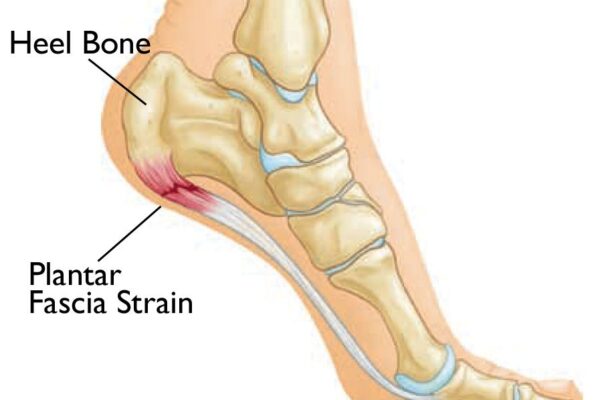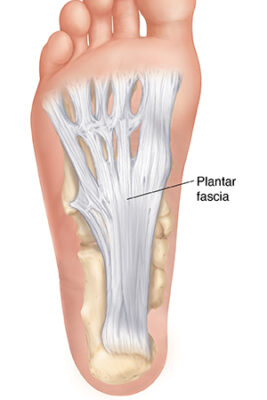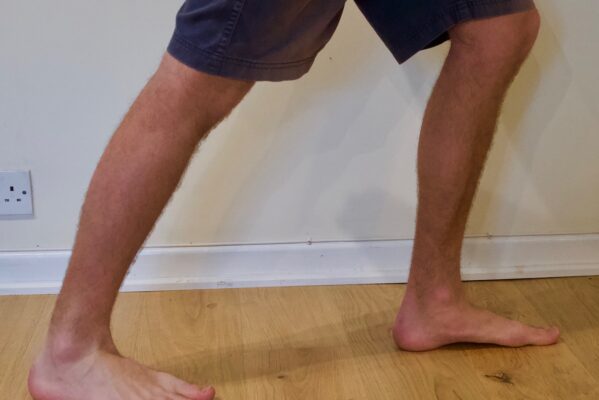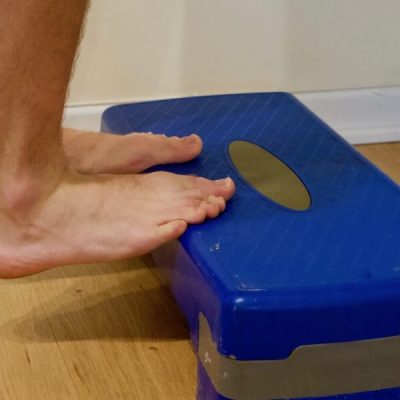What is Plantar Fasciitis?
Plantar fasciitis is the most common cause of pain on the bottom of the heel. Approximately 2 million patients are treated for this condition every year.
Plantar fasciitis occurs when the strong band of tissue that supports the arch of your foot becomes irritated and inflamed.


Where is the plantar fascia?
The plantar fascia is a long, thin ligament that connects the heel to the front of the foot and provides support
What is the cause of problems?
The plantar fascia’s job is to absorb the stresses and strains we place on our feet. However too much pressure damages or tears the tissues which leads to heel pain and stiffness of the plantar fascia.
Risk Factors
Plantar fasciitis usually develops without any specific single reason but there are several factors that can make you more likely to get it.
- Tight calf muscles
- Obesity
- Very high arch or flat feet
- Repetitive impact activity (running/sports)
- New or increased activity
- Age tends to affect people in the 40-60 age group
- People who tend to stand for long periods in their job
Heel Spurs
Although many people with plantar fasciitis do in fact have heel spurs, the spurs are not usually the cause of plantar fasciitis pain. One out of 10 people has heel spurs, but only 1 out of 20 people (5%) with heel spurs has foot pain. Therefore you can cure the problem without removing the spur.
What are the symptoms?
The most common symptoms are
Pain on the bottom of the foot near the heel
Pain with the first few steps after getting out of bed in the morning
Pain when moving after sitting for a long time which eases after a few minutes of walking.
Increased pain after (not during) exercise or activity
Examination
The doctor will listen to your description of the problem and then look and feel for the point of pain and the range of motion of the ankle. They will see if the pain becomes worse when the foot is flexed up and pressure is put on the plantar fascia.
X-rays
X-rays may be requested to rule out any other cause of pain such as heel spurs or arthritis.

Treatment
Nonsurgical Treatment
More than 90% of patients with plantar fasciitis will improve within 10 months of starting simple treatment methods.
Rest
Try decreasing or even stopping any activity that increases your pain. This may mean stopping any sport that means running around on a hard surface.
Ice
Ice can be an effective painkiller and anti-inflammatory so place an ice pack over the area for 10-20 mins 3-4 times a day.
Drugs such as ibuprofen or naproxen reduce pain and inflammation but try not to use for more than 1 month.
Exercise
Plantar fasciitis is aggravated by tight muscles in your feet and calves. Stretching your calves and plantar fascia is the most effective way to relieve the pain that comes with this condition.

Calf stretch
Stand with one leg in front of the other. Then lean forwards onto the front leg keeping the back knee straight and the heel on the ground.
Hold the position for 10 seconds and relax. Repeat x 20
You should feel a strong stretch in the calf
Calf and Achilles stretch
Stand on the edge of a step with your forefoot safely on the step. Let your heels drop down. Feel the stretch in the calf and the Achilles tendon. Hold for 10 seconds and repeat x 10

Plantar fascia stretch
In sitting cross your affected foot over the knee of your other leg. Then holding the toes of your painful foot and slowly pull them towards you. Hold the stretch for 10 seconds and repeat x 20 for each foot.
This exercise is best done in the morning before standing or walking.
Cortisone injections
Cortisone, a type of steroid, is a powerful anti-inflammatory medication. This can be injected into the plantar fascia to reduce inflammation and pain. You can only have a limited number of injections as more than this can cause ruptures of the fascia.

Supportive shoes and orthotics
Try and wear shoes with thick and well cushioned soles. This can reduce pain with standing and walking as it cushions your heel strike. A further silicon heel inserted in to your shoes raise your heel a little which further takes the strain off the fascia.
You may benefit with going to see a podiatrist to assess your foot posture.
Or simply buying a ready made orthotic insole directly such as NEOthotics sold in Argos and Boots
Night splints
Generally people sleep with their feet pointed down which relaxes the plantar fascia so this explains the acute pain when you first step out of bed in the morning. If you wear a splint at night the plantar fascia remains stretched at night which can be very effective at curing the problem.
Physiotherapy
Treatment will focus on stretching the calf muscles and plantar fascia. Also the therapist may do ultrasound to help decrease the inflammation.
You may be shown how to tape with K tape to take the pressure off the plantar fascia.Your physiotherapist may also look at your posture and suggest whether you need orthotics or a heel wedge.
How to tape for Plantar fasciitis
- Apply the first anchor strip
Make sure your foot is relaxed when applying the tape. If you have the foot too tense then when you go to stand up it will tighten even further and be uncomfortable. Apply anchor strips around the forefoot making sure there is no tension whatsoever in the tape. If you prefer, do not attach the tape all the way around. The purpose of the anchor strips is to provide a secure area to attach the supporting strips.
- Apply the second anchor strip
Apply another anchor strip around the heel in the same way. Make sure you do not have any kinks or ripples in the tape as this may make it uncomfortable.
- Apply the support strips
Apply support strips along the length of the foot from the heel to the forefoot anchor strips. Begin in the middle of the heel and apply strips in a fan shape. You can either tear the tape first or apply it and then tear from the roll at the appropriate length. Apply a final strip along the inside of the arch for additional support.
- Reinforce the original anchor strips
Finally, apply more strips of tape over the original anchor strips to secure the support strips.
You can find videos on youtube to help you
Extracorporeal shockwave therapy (ESWT) this is a high-energy shockwave treatment which is meant to help stimulate the healing process in the tissues.
ESWT has not shown consistent results but may be tried before surgery is considered
Surgical Treatment
Surgery is considered only after 12 months of aggressive nonsurgical treatment.
Gastrocnemius recession. This is a surgical lengthening of the calf muscles, as tight calf muscles increase stress on the plantar fascia.This procedure is useful for patients who have difficulty flexing their feet up despite a year of calf stretches.
Plantar fascia release. If you have a normal range of ankle movement but continue to have heel pain, you may want to consider a partial release procedure. The surgeon will partially cut the plantar fascia ligament which relieves tension. If you have a large bone spur that will also be removed. Although the surgery can be performed endoscopically it is much more difficult than with an open incision.
Complications. The most common complications of release surgery include incomplete relief of pain and nerve damage.
Recovery. Most patients have good results from surgery. However, because surgery can result in chronic pain and dissatisfaction, it is recommended only after all nonsurgical measures have been exhausted.

